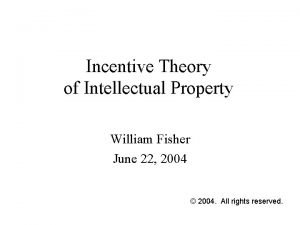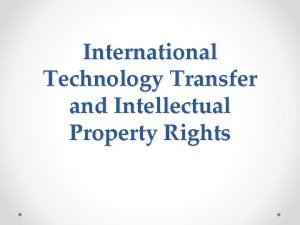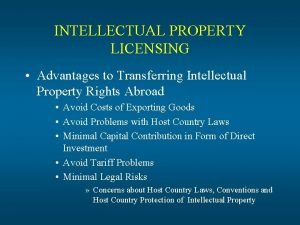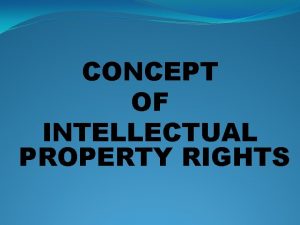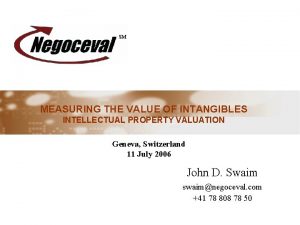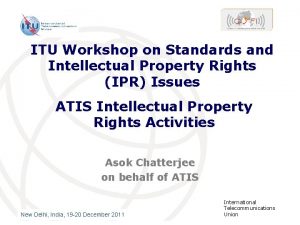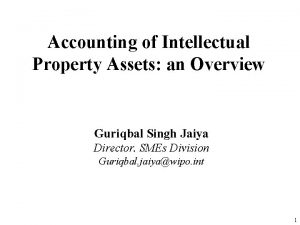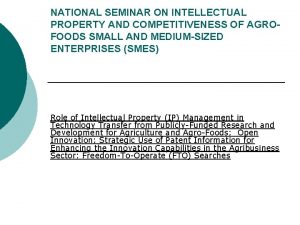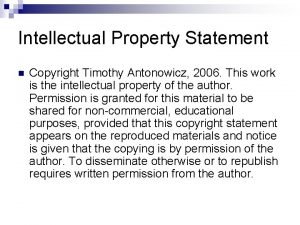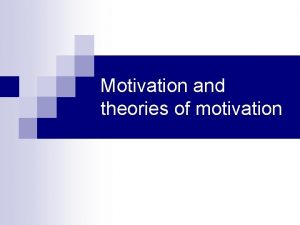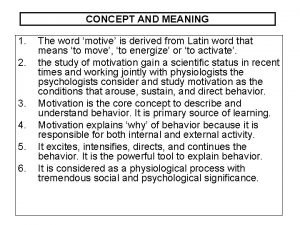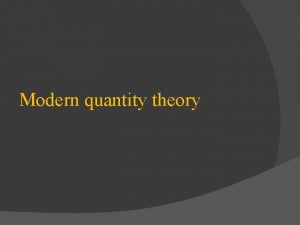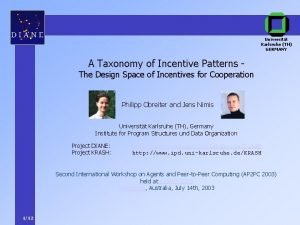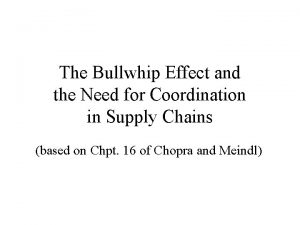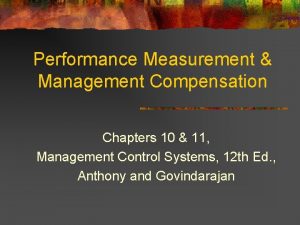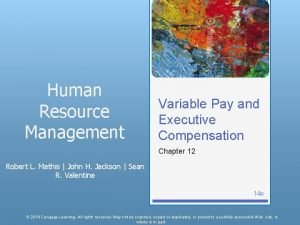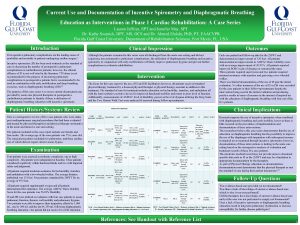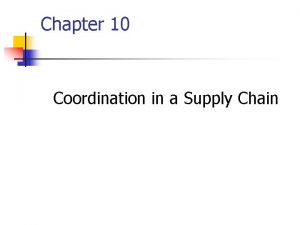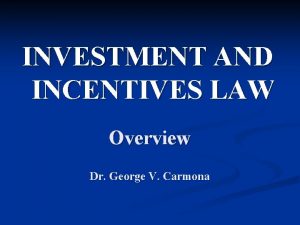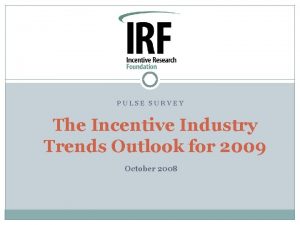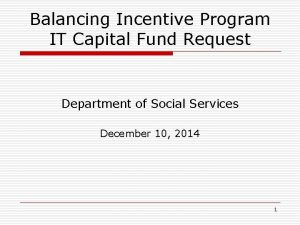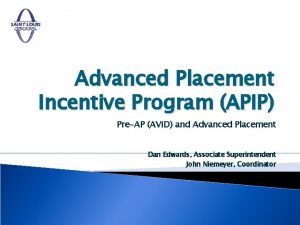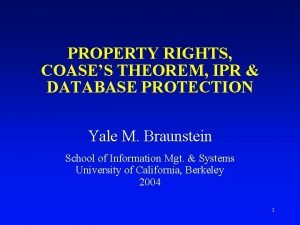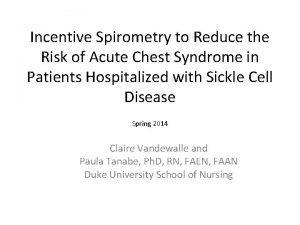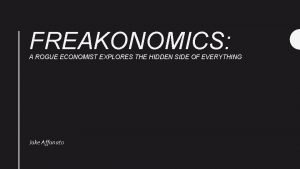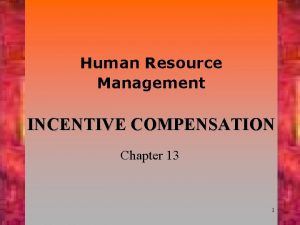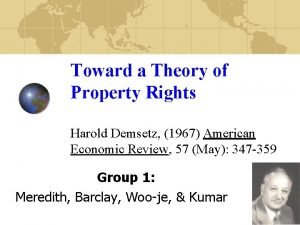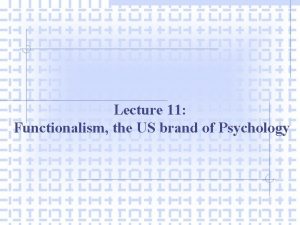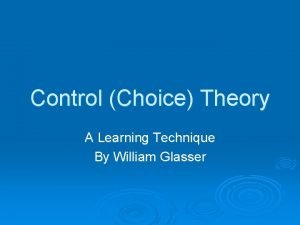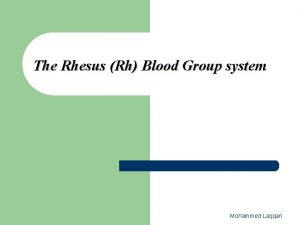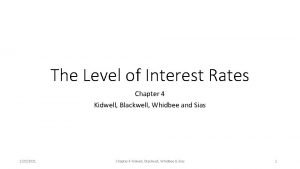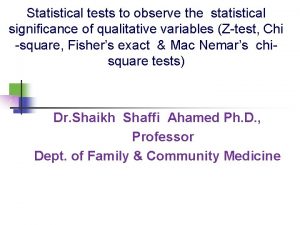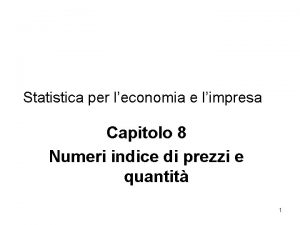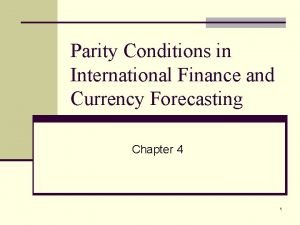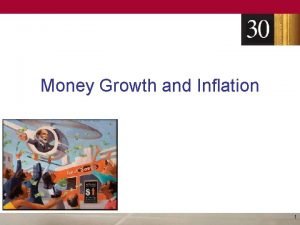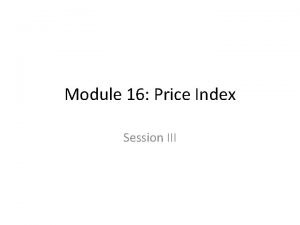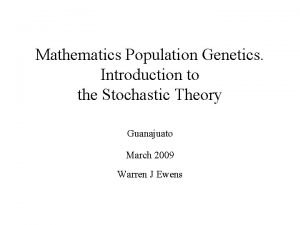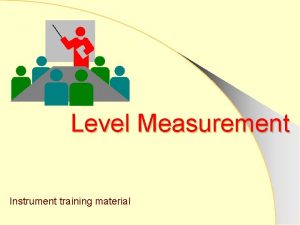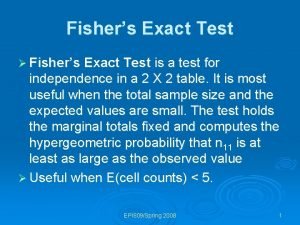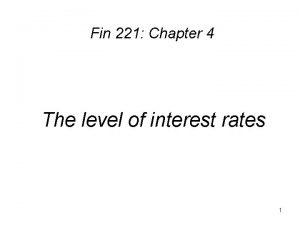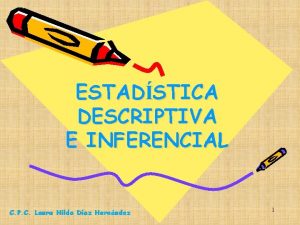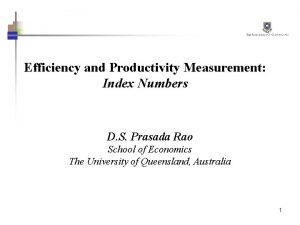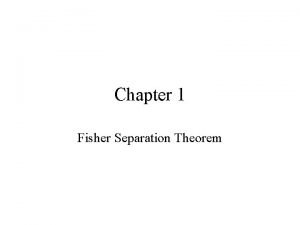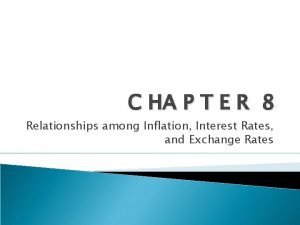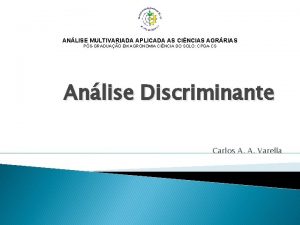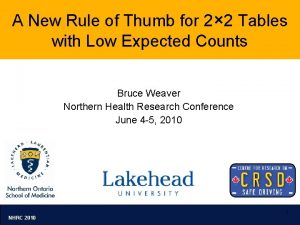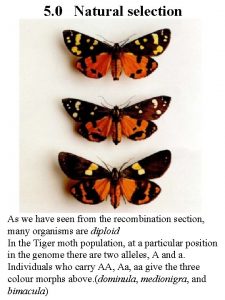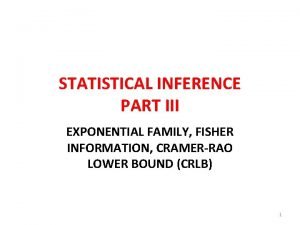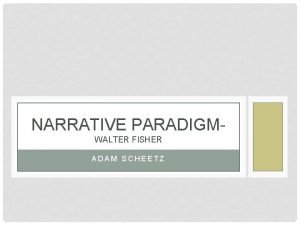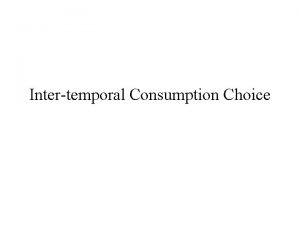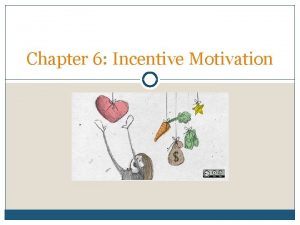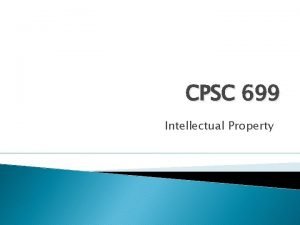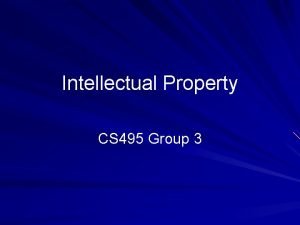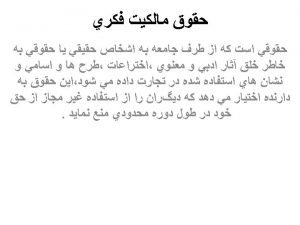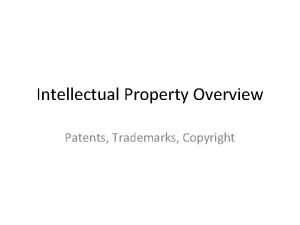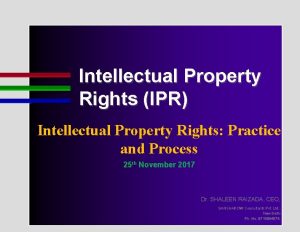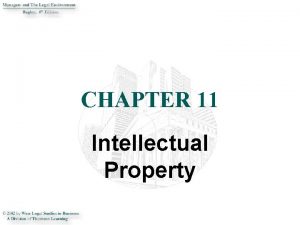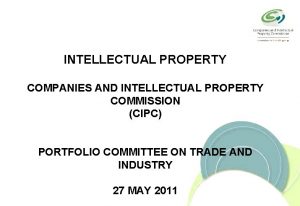Incentive Theory of Intellectual Property William Fisher June












































































































































- Slides: 140

Incentive Theory of Intellectual Property William Fisher June 22, 2004 © 2004. All rights reserved.

Intellectual Products are “Public Goods” • Can be used and enjoyed by an infinite number of persons without being “used up” • It is difficult to exclude people from access to the good Creates a danger that an inefficiently low number of such goods will be produced

Possible Responses to Public-Goods Problem (1) Government provides the good -- e. g. , lighthouses; armed forces (2) Government subsidizes production of the activity -- e. g. , NIH funding for basic scientific research; NEA (3) Government issues prizes -- e. g. , X-prize and associated shift in NASA policy -- e. g. , compensated expropriation of patents (4) Government confers monopoly power on producers -- e. g. , 19 th c. toll roads; intellectual-property rights (5) Government assists private parties in increasing “excludability” -- trade-secret law; “direct molding” prohibitions; anticircumvention laws

Improved Knee Brace

Improved Knee Brace





Economic Conditions Created by the Grant of a Patent $ Quantity

Economic Conditions Created by the Grant of a Patent $ Marginal Cost Quantity

Economic Conditions Created by the Grant of a Patent $ Willingness and ability to pay of consumer X P(X) Marginal Cost X Quantity

Economic Conditions Created by the Grant of a Patent $ Willingness and ability to pay of consumer Y P(X) P(Y) Marginal Cost X Y Quantity

Economic Conditions Created by the Grant of a Patent $ Willingness and ability to pay of consumer Z P(X) P(Y) P(Z) Marginal Cost X Y Z Quantity

Economic Conditions Created by the Grant of a Patent $ Aggregate Consumer Demand P(X) De P(Y) ma nd P(Z) Marginal Cost X Y Z Quantity

Economic Conditions Created by the Grant of a Patent $ In the absence of patent, copying and competition will drive the price down close to marginal cost P(X) De P(Y) ma nd P(Z) Marginal Cost X Y Z Quantity

Economic Conditions Created by the Grant of a Patent $ In the absence of patent, copying and competition will drive the price down close to marginal cost P(X) De P(Y) ma nd P(Z) Marginal Cost X Y Z Quantity

Economic Conditions Created by the Grant of a Patent $ In the absence of patent, copying and competition will drive the price down close to marginal cost P(X) De P(Y) ma nd P(Z) Marginal Cost X Y Z Quantity

Economic Conditions Created by the Grant of a Patent $ In the absence of patent, copying and competition will drive the price down close to marginal cost P(X) De P(Y) ma nd P(Z) Marginal Cost X Y Z Quantity

Economic Conditions Created by the Grant of a Patent $ In the absence of patent, copying and competition will drive the price down close to marginal cost P(X) De P(Y) ma nd P(Z) Marginal Cost X Y Z Quantity

Economic Conditions Created by the Grant of a Patent $ In the absence of patent, copying and competition will drive the price down close to marginal cost P(X) De P(Y) ma nd P(Z) Marginal Cost X Y Z Quantity

Economic Conditions Created by the Grant of a Patent $ In the absence of patent, copying and competition will drive the price down close to marginal cost P(X) De P(Y) ma nd P(Z) Marginal Cost X Y Z Quantity

Economic Conditions Created by the Grant of a Patent $ In the absence of patent, copying and competition will drive the price down close to marginal cost P(X) De P(Y) ma nd P(Z) Marginal Cost X Y Z Quantity

Economic Conditions Created by the Grant of a Patent $ In the absence of patent, copying and competition will drive the price down close to marginal cost P(X) De P(Y) ma nd P(Z) Marginal Cost X Y Z Quantity

Economic Conditions Created by the Grant of a Patent $ In the absence of patent, copying and competition will drive the price down close to marginal cost P(X) De P(Y) ma nd P(Z) Marginal Cost X Y Z Q Quantity

Economic Conditions Created by the Grant of a Patent $ In the absence of patent, copying and competition will drive the price down close to marginal cost Resultant Consumer Surplus P(X) De P(Y) ma nd P(Z) Marginal Cost X Y Z Q Quantity

Economic Conditions Created by the Grant of a Patent $ In the absence of patent, copying and competition will drive the price down close to marginal cost P(X) De P(Y) ma nd P(Z) Marginal Cost X Y Z Q Quantity

Economic Conditions Created by the Grant of a Patent $ P(X) De P(Y) ma nd P(Z) Marginal Cost X Y Z Quantity

Economic Conditions Created by the Grant of a Patent $ Profit-Maximizing Behavior by a Patentee who can engage in perfect price discrimination P(X) De P(Y) ma nd P(Z) Marginal Cost X Y Z Quantity

Economic Conditions Created by the Grant of a Patent $ Profit-Maximizing Behavior by a Patentee who can engage in perfect price discrimination P(X) De P(Y) ma nd P(Z) Marginal Cost X Y Z Quantity

Economic Conditions Created by the Grant of a Patent $ Profit-Maximizing Behavior by a Patentee who can engage in perfect price discrimination “Monopoly Profits” P(X) De P(Y) ma P(Z) nd Marginal Cost X Y Z Profit-maximizing output Quantity

$ A Figure 1: Profit-Maximizing Behavior by a Patentee In the absence of Price Discrimination De ma nd C O G Marginal Cost H I Quantity

$ A Figure 1: Profit-Maximizing Behavior by a Patentee In the absence of Price Discrimination p De ma nd C O G Marginal Cost H I Quantity

$ A Figure 1: Profit-Maximizing Behavior by a Patentee In the absence of Price Discrimination p De ma nd C O u G Marginal Cost H I Quantity

$ A Figure 1: Profit-Maximizing Behavior by a Patentee In the absence of Price Discrimination Revenues p De ma nd C O u G Marginal Cost H I Quantity

$ A Figure 1: Profit-Maximizing Behavior by a Patentee In the absence of Price Discrimination Costs p De ma nd C O u G Marginal Cost H I Quantity

$ A Figure 1: Profit-Maximizing Behavior by a Patentee In the absence of Price Discrimination Profits p De ma nd C O u G Marginal Cost H I Quantity

$ A Figure 1: Profit-Maximizing Behavior by a Patentee In the absence of Price Discrimination p De ma nd C O u G Marginal Cost H I Quantity

$ A Figure 1: Profit-Maximizing Behavior by a Patentee In the absence of Price Discrimination p q De ma nd C O u G Marginal Cost H I Quantity

$ A Figure 1: Profit-Maximizing Behavior by a Patentee In the absence of Price Discrimination p q De ma nd C O uv G Marginal Cost H I Quantity

$ A Figure 1: Profit-Maximizing Behavior by a Patentee In the absence of Price Discrimination Revenue loss p q De ma nd C O uv G Marginal Cost H I Quantity

$ A Figure 1: Profit-Maximizing Behavior by a Patentee In the absence of Price Discrimination Revenue loss Revenue gain p q De ma nd C O uv G Marginal Cost H I Quantity

$ A Figure 1: Profit-Maximizing Behavior by a Patentee In the absence of Price Discrimination Profits p q De ma nd C O uv G Marginal Cost H I Quantity

$ A Figure 1: Profit-Maximizing Behavior by a Patentee In the absence of Price Discrimination p q De ma nd r C O uv G Marginal Cost H I Quantity

$ A Figure 1: Profit-Maximizing Behavior by a Patentee In the absence of Price Discrimination p q De ma nd r C O uv w G Marginal Cost H I Quantity

$ A Figure 1: Profit-Maximizing Behavior by a Patentee In the absence of Price Discrimination Revenue loss p q De ma nd r C O uv w G Marginal Cost H I Quantity

$ A Figure 1: Profit-Maximizing Behavior by a Patentee In the absence of Price Discrimination Revenue loss p q De ma nd r C O uv w Revenue gain G Marginal Cost H I Quantity

$ A Figure 1: Profit-Maximizing Behavior by a Patentee In the absence of Price Discrimination p q Profit De ma nd r C O uv w G Marginal Cost H I Quantity

$ A Figure 1: Profit-Maximizing Behavior by a Patentee In the absence of Price Discrimination De ma nd C O G Marginal Cost H I Quantity

$ A Figure 1: Profit-Maximizing Behavior by a Patentee In the absence of Price Discrimination Marginal Revenue De ma nd C O G Marginal Cost H I Quantity

$ A Figure 1: Profit-Maximizing Behavior by a Patentee In the absence of Price Discrimination D B C O Marginal Revenue De ma nd G Marginal Cost H I E F Quantity

Profit-maximizing price $ A Figure 1: Profit-Maximizing Behavior by a Patentee In the absence of Price Discrimination D B C O Marginal Revenue De ma nd G Marginal Cost H I E F Profit-maximizing output Quantity

Profit-maximizing price $ A Figure 1: Profit-Maximizing Behavior by a Patentee In the absence of Price Discrimination Monopoly Profits D B De ma nd 1 C O Marginal Revenue G Marginal Cost H I E F Profit-maximizing output Quantity

Figure 2: Economic Effects of Profit-Maximizing Behavior by a Patentee Profit-maximizing price $ A Consumer Surplus Monopoly Profits 2 D B 1 C O De ma nd E F G Marginal Cost H I Profit-maximizing output Quantity

Figure 2: Economic Effects of Profit-Maximizing Behavior by a Patentee Profit-maximizing price $ A Consumer Surplus Monopoly Profits 2 D B De ma nd 1 C O E 3 Deadweight Loss (foregone consumer surplus) G Marginal Cost H I E F Profit-maximizing output Quantity

Applications of Reward Theory • Assessing the merits and demerits of partial price discrimination • Assessing the merits and demerits of compulsory licenses • Determining the Optimal Pattern of Entitlements (possible in theory, not in practice) • Posner’s “positive” account of extant doctrine

Applications of Reward Theory • Assessing the merits and demerits of partial price discrimination • Assessing the merits and demerits of compulsory licenses • Determining the Optimal Pattern of Entitlements (possible in theory, not in practice) • Posner’s “positive” account of extant doctrine

Partial Price Discrimination $ Marginal Cost O Quantity

Partial Price Discrimination $ Marginal Cost O u v w x Discrete markets y Quantity

Partial Price Discrimination $ p Monopoly Profits Marginal Cost O u v w x y Quantity

Partial Price Discrimination $ p q Monopoly Profits Marginal Cost O u v w x y Quantity

Partial Price Discrimination $ p q r Monopoly Profits Marginal Cost O u v w x y Quantity

Partial Price Discrimination $ p q r s Monopoly Profits Marginal Cost O u v w x y Quantity

Partial Price Discrimination $ p q r s Monopoly Profits t Marginal Cost O u v w x y Quantity

Illustrations of Price Discrimination Techniques • “Second Degree”: Offer 2 models: – Regular for $250 – Premium (carbon-fiber) for $500 • “Third Degree”: Price varies by zip code of purchaser’s residence

Figure 2. 4: Market Windows from Release Date Domestic Theatrical Foreign Theatrical Pay per view Home Video Pay TV Foreign TV Network TV Syndication 0 1 2 3 4 Time in Years 5 6 7

Example of Partial Price Discrimination Licensing first-runs in movie theatres $ Licensing for pay-per-view Licensing for home video rental Licensing for network broadcast Licensing for local broadcas D 1 2 3 Marginal Cost 4 5 G Quantity

Figure 3: Economic Impact of Partial Price Discrimination $ p q r s t Consumer Surplus 2 Monopoly Profits 1 D O u v w Marginal Cost x y Quantity

Figure 3: Economic Impact of Partial Price Discrimination $ p q r s t Consumer Surplus 2 Monopoly Profits 1 3 D O u v w x Marginal Cost Quantity y Deadweight Loss

Figure 3: Economic Impact of Partial Price Discrimination $ Consumer Surplus 2 Monopoly Profits 1 D O 3 Marginal Cost Quantity Deadweight Loss

Figure 2: No Price Discrimination $ Consumer Surplus 2 Monopoly Profits 1 E 3 Marginal Cost E O Quantity Deadweight Loss

Effects of Partial Price Discrimination on Consumer Surplus No price discrimination Partial Price Discrimination Relative Size of the Surpluses depends on how finely the copyright owner can slice up the market

Effects of Partial Price Discrimination Ø Enables Creators to Make More Money Ø Reduces deadweight loss Ø Indeterminate impact on consumer surplus Ø Increases ratio between incentive for creativity and deadweight loss -- thus enhances net consumer welfare Ø Increases the likelihood that all persons will have access to works of the intellect Ø Increases Transaction Costs Ø Distortions caused by 2 nd degree PD alternatives Ø Possible invasions of privacy Ø Possible threat to cumulative innovation

Applications of Reward Theory • Assessing the merits and demerits of partial price discrimination • Assessing the merits and demerits of compulsory licenses • Determining the Optimal Pattern of Entitlements (possible in theory, not in practice) • Posner’s “positive” account of extant doctrine

Applications of Reward Theory • Assessing the merits and demerits of partial price discrimination • Assessing the merits and demerits of compulsory licenses • Determining the Optimal Pattern of Entitlements (possible in theory, not in practice) • Posner’s “positive” account of extant doctrine

Figure 2: Economic Effects of Profit-Maximizing Behavior by a Patentee $ Consumer Surplus Profit-maximizing price Monopoly Profits De ma nd E Deadweight Loss (foregone consumer surplus) Marginal Cost Quantity Profit-maximizing output

Figure 2: Economic Effects of Profit-Maximizing Behavior by a Patentee $ Profit-maximizing price Monopoly Profits De ma nd E Deadweight Loss (foregone consumer surplus) Marginal Cost Quantity Profit-maximizing output

Figure 2: Economic Effects of Profit-Maximizing Behavior by a Patentee $ Profit-maximizing price Monopoly Profits De ma nd Marginal Cost Quantity Profit-maximizing output

Figure 2: Economic Effects of Profit-Maximizing Behavior by a Patentee $ Profit-maximizing price Monopoly Profits Force Patentee to License the work for reduced fee De ma nd Marginal Cost Quantity Profit-maximizing output

Figure 2: Economic Effects of Profit-Maximizing Behavior by a Patentee $ Monopoly Profits Force Patentee to License the work for reduced fee De ma nd Marginal Cost Quantity Profit-maximizing output

Figure 2: Economic Effects of Profit-Maximizing Behavior by a Patentee $ Force Patentee to License the work for reduced fee De ma nd E Marginal Cost Quantity Profit-maximizing output

Economic Impact of a Compulsory Licensing System $ License Fee Monopoly Profits De ma nd D Marginal Cost Quantity

Economic Impact of a Compulsory Licensing System $ Monopoly Profits License Fee Deadweight Loss De ma nd D Marginal Cost Quantity

Economic Impact of a Compulsory Licensing System $ Consumer Surplus Monopoly Profits License Fee Deadweight Loss De ma nd D Marginal Cost Quantity

Effects of Compulsory Licensing on Consumer Surplus No price regulation Compulsory license Advantages of the Compulsory license will be offset, at least partially, by administrative costs

Effects of Compulsory Licensing on Incentive to Loss Ratio • Reduce monopoly profits moderately • Reduce deadweight loss substantially • Increase administrative costs May increase the overall ratio

Applications of Reward Theory • Assessing the merits and demerits of partial price discrimination • Assessing the merits and demerits of compulsory licenses • Determining the Optimal Pattern of Entitlements (possible in theory, not in practice) • Posner’s “positive” account of extant doctrine

Applications of Reward Theory • Assessing the merits and demerits of partial price discrimination • Assessing the merits and demerits of compulsory licenses • Determining the Optimal Pattern of Entitlements (possible in theory, not in practice) • Posner’s “positive” account of extant doctrine

Determining Optimal Levels of Patent Protection

Determining Optimal Levels of Patent Protection (1) Ascertain the incentive/loss ratio for each of the set of possible entitlements

Determining Optimal Levels of Patent Protection (1) Ascertain the incentive/loss ratio for each of the set of possible entitlements B 58/25=2. 32

Determining Optimal Levels of Patent Protection (1) Ascertain the incentive/loss ratio for each of the set of possible entitlements B C 58/25=2. 32 17/8=2. 13

Determining Optimal Levels of Patent Protection (1) Ascertain the incentive/loss ratio for each of the set of possible entitlements E B C 58/25=2. 32 17/8=2. 13 75/108=0. 69

Determining Optimal Levels of Patent Protection (1) Ascertain the incentive/loss ratio for each of the set of possible entitlements E D 75/108=0. 69 100/92=1. 09 B C 58/25=2. 32 17/8=2. 13

Determining Optimal Levels of Patent Protection (1) Ascertain the incentive/loss ratio for each of the set of possible entitlements E D A B C 58/25=2. 32 17/8=2. 13 75/108=0. 69 100/92=1. 09 75/17=4. 41

Determining Optimal Levels of Patent Protection (1) Ascertain the incentive/loss ratio for each of the set of possible entitlements (2) Arrange them from highest ratio to lowest E D A B C 58/25=2. 32 17/8=2. 13 75/108=0. 69 100/92=1. 09 75/17=4. 41

Determining Optimal Levels of Patent Protection (1) Ascertain the incentive/loss ratio for each of the set of possible entitlements (2) Arrange them from highest ratio to lowest A D E 100/92=1. 09 75/108=0. 69 B C 75/17=4. 41 58/25=2. 32 17/8=2. 13

Determining Optimal Levels of Patent Protection (1) Ascertain the incentive/loss ratio for each of the set of possible entitlements (2) Arrange them from highest ratio to lowest (3) Plot the sequence on a graph so that the line corresponding to aggregate reward is linear A D E 100/92=1. 0 9 75/108=0. 6 9 B C 75/17=4. 41 58/25=2. 32 17/8=2. 13

Determining Optimal Levels of Patent Protection (no patent protection)

Determining Optimal Levels of Patent Protection Reward to Producers In the absence of any patent protection (no patent protection)

Determining Optimal Levels of Patent Protection Aggregate Reward to Producers caused by forbidding each successive use (no patent protection) Reward to Producers In the absence of any patent protection

Determining Optimal Levels of Patent Protection 75 (no patent protection) Aggregate Reward to Producers caused by forbidding each successive use A Reward to Producers In the absence of any v protection

Determining Optimal Levels of Patent Protection 58 75 (no patent protection) Aggregate Reward to Producers caused by forbidding each successive use A B Reward to Producers In the absence of any patent protection

Determining Optimal Levels of Patent Protection 17 58 75 (no patent protection) Aggregate Reward to Producers caused by forbidding each successive use A B C Reward to Producers In the absence of any patent protection

Determining Optimal Levels of v Protection 100 17 58 75 (no patent protection) Aggregate Reward to Producers caused by forbidding each successive use A B C Reward to Producers In the absence of any patent protection D

Determining Optimal Levels of Patent Protection 75 100 17 58 75 (no patent protection) Aggregate Reward to Producers caused by forbidding each successive use A B C Reward to Producers In the absence of any patent protection D E

Determining Optimal Levels of Patent Protection Aggregate Reward to Producers caused by forbidding each successive use (no patent protection) A B C D E

Determining Optimal Levels of Patent Protection (1) Ascertain the incentive/loss ratio for each of the set of possible entitlements (2) Arrange them from highest ratio to lowest (3) Plot the sequence on a graph so that the line corresponding to aggregate reward is linear

Determining Optimal Levels of Patent Protection (1) Ascertain the incentive/loss ratio for each of the set of possible entitlements (2) Arrange them from highest ratio to lowest (3) Plot the sequence on a graph so that the line corresponding to aggregate reward is linear (4) Plot the corresponding levels of aggregate social loss

Determining Optimal Levels of Patent Protection Aggregate Reward to Producers caused by forbidding each successive use (no patent protection) A B C D E

Determining Optimal Levels of Patent Protection (no patent protection) A B C D E

Determining Optimal Levels of Patent Protection Aggregate Efficiency Loss caused by forbidding each successive use (no patent protection) A B C D E

Determining Optimal Levels of Patent Protection Aggregate Efficiency Loss caused by forbidding each successive use (no patent protection) A B C D E

Determining Optimal Levels of Patent Protection Aggregate Efficiency Loss caused by forbidding each successive use (no patent protection) A B C D E

Determining Optimal Levels of Patent Protection Aggregate Efficiency Loss caused by forbidding each successive use (no patent protection) A B C D E

Determining Optimal Levels of Patent Protection Aggregate Efficiency Loss caused by forbidding each successive use (no patent protection) A B C D E

Determining Optimal Levels of Patent Protection Aggregate Reward to Producers caused by forbidding each successive use (no patent protection) A B C Aggregate Efficiency Loss caused by forbidding each successive use D E

Determining Optimal Levels of Patent Protection (1) Ascertain the incentive/loss ratio for each of the set of possible entitlements (2) Arrange them from highest ratio to lowest (3) Plot the sequence on a graph so that the line corresponding to aggregate reward is linear (4) Plot the corresponding levels of aggregate social loss

Determining Optimal Levels of Patent Protection (1) Ascertain the incentive/loss ratio for each of the set of possible entitlements (2) Arrange them from highest ratio to lowest (3) Plot the sequence on a graph so that the line corresponding to aggregate reward is linear (4) Plot the corresponding levels of aggregate social loss (5) Plot the efficiency gains associated with each increase in aggregate reward

Determining Optimal Levels of Patent Protection Aggregate Reward to Producers caused by forbidding each successive use (no patent protection) A B C Aggregate Efficiency Loss caused by forbidding each successive use D E

Determining Optimal Levels of Patent Protection Efficiency Gains caused by increased productivity induced by each level of reward Aggregate Reward to Producers caused by forbidding each successive use (no patent protection) A B C Aggregate Efficiency Loss caused by forbidding each successive use D E

Determining Optimal Levels of Patent Protection Efficiency Gains caused by increased productivity induced by each level of reward Aggregate Reward to Producers caused by forbidding each successive use (no patent protection) A B C Aggregate Efficiency Loss caused by forbidding each successive use D E

Determining Optimal Levels of Patent Protection Efficiency Gains caused by increased productivity induced by each level of reward Aggregate Reward to Producers caused by forbidding each successive use (no patent protection) A B C Aggregate Efficiency Loss caused by forbidding each successive use D E

Determining Optimal Levels of Patent Protection Efficiency Gains caused by increased productivity induced by each level of reward Aggregate Reward to Producers caused by forbidding each successive use (no patent protection) A B C Aggregate Efficiency Loss caused by forbidding each successive use D E

Determining Optimal Levels of Patent Protection Efficiency Gains caused by increased productivity induced by each level of reward Aggregate Reward to Producers caused by forbidding each successive use (no patent protection) A B C Aggregate Efficiency Loss caused by forbidding each successive use D E

Determining Optimal Levels of Patent Protection Efficiency Gains caused by increased productivity induced by each level of reward Aggregate Reward to Producers caused by forbidding each successive use (no patent protection) A B C Aggregate Efficiency Loss caused by forbidding each successive use D E

Determining Optimal Levels of Patent Protection (1) Ascertain the incentive/loss ratio for each of the set of possible entitlements (2) Arrange them from highest ratio to lowest (3) Plot the sequence on a graph so that the line corresponding to aggregate reward is linear (4) Plot the corresponding levels of aggregate social loss (5) Plot the efficiency gains associated with each increase in aggregate reward

Determining Optimal Levels of Patent Protection (1) Ascertain the incentive/loss ratio for each of the set of possible entitlements (2) Arrange them from highest ratio to lowest (3) Plot the sequence on a graph so that the line corresponding to aggregate reward is linear (4) Plot the corresponding levels of aggregate social loss (5) Plot the efficiency gains associated with each increase in aggregate reward (6) Plot difference between top and bottom lines

Determining Optimal Levels of Patent Protection Efficiency Gains caused by increased productivity induced by each level of reward Aggregate Reward to Producers caused by forbidding each successive use (no patent protection) A B C Aggregate Efficiency Loss caused by forbidding each successive use D E

Determining Optimal Levels of Patent Protection Efficiency Gains caused by increased productivity induced by each level of reward Aggregate Reward to Producers caused by forbidding each successive use (no patent protection) A B C Aggregate Efficiency Loss caused by forbidding each successive use D E

Determining Optimal Levels of Patent Protection Efficiency Gains caused by increased productivity induced by each level of reward Aggregate Reward to Producers caused by forbidding each successive use (no patent protection) A B C Aggregate Efficiency Loss caused by forbidding each successive use D E

Determining Optimal Levels of Patent Protection Efficiency Gains caused by increased productivity induced by each level of reward Aggregate Reward to Producers caused by forbidding each successive use (no patent protection) A B C Aggregate Efficiency Loss caused by forbidding each successive use D E

Determining Optimal Levels of Patent Protection Efficiency Gains caused by increased productivity induced by each level of reward Aggregate Reward to Producers caused by forbidding each successive use (no patent protection) A B C Aggregate Efficiency Loss caused by forbidding each successive use D E

Determining Optimal Levels of Patent Protection Efficiency Gains caused by increased productivity induced by each level of reward Aggregate Reward to Producers caused by forbidding each successive use (no patent protection) A B C Aggregate Efficiency Loss caused by forbidding each successive use D E

Determining Optimal Levels of Patent Protection Efficiency Gains caused by increased productivity induced by each level of reward Net impact on economic efficiency of forbidding each successive use Aggregate Reward to Producers caused by forbidding each successive use (no patent protection) A B C Aggregate Efficiency Loss caused by forbidding each successive use D E

Determining Optimal Levels of Patent Protection Efficiency Gains caused by increased productivity induced by each level of reward Identify Highest Point Net impact on economic efficiency of forbidding each successive use Aggregate Reward to Producers caused by forbidding each successive use (no patent protection) A B C Aggregate Efficiency Loss caused by forbidding each successive use D E

Determining Optimal Levels of Patent Protection Efficiency Gains caused by increased productivity induced by each level of reward Assign these entitlements To patentees Net impact on economic efficiency of forbidding each successive use Aggregate Reward to Producers caused by forbidding each successive use (no patent protection) A B C Aggregate Efficiency Loss caused by forbidding each successive use D E

Determining Optimal Levels of Patent Protection Efficiency Gains caused by increased productivity induced by each level of reward Deny these entitlements To patentees Assign these entitlements To patentees Net impact on economic efficiency of forbidding each successive use Aggregate Reward to Producers caused by forbidding each successive use (no patent protection) A B C Aggregate Efficiency Loss caused by forbidding each successive use D E

Determining Optimal Levels of Patent Protection Very rough guidelines: Grant to patentees entitlements that carry with them large ratios – and refuse to excuse encroachments upon those entitlements Deny to patentees entitlements that carry with them small ratios – or grant the entitlements but excuse encroachments upon those entitlements

Applications of Reward Theory • Assessing the merits and demerits of partial price discrimination • Assessing the merits and demerits of compulsory licenses • Determining the Optimal Pattern of Entitlements (possible in theory, not in practice) • Posner’s “positive” account of extant doctrine
 Incentive theory
Incentive theory Trade related aspects of intellectual property rights
Trade related aspects of intellectual property rights Intellectual property in professional practices
Intellectual property in professional practices Importance of intellectual property
Importance of intellectual property Intellectual property management definition
Intellectual property management definition Advantages of intellectual property
Advantages of intellectual property Intellectual property in business plan
Intellectual property in business plan Intellectual property in computer ethics
Intellectual property in computer ethics Right to intellectual property of teachers
Right to intellectual property of teachers Intellectual property law definition
Intellectual property law definition Concept of intellectual property
Concept of intellectual property Valuing intangible assets
Valuing intangible assets Intellectual property rights
Intellectual property rights Intellectual property rights
Intellectual property rights Characteristics of intellectual property
Characteristics of intellectual property Discuss intellectual property frankly
Discuss intellectual property frankly Intangible inputs
Intangible inputs Intellectual property
Intellectual property Intellectual property statement
Intellectual property statement Intellectual property business plan example
Intellectual property business plan example Evalueserve patent search
Evalueserve patent search Discuss intellectual property frankly
Discuss intellectual property frankly At&t intellectual property
At&t intellectual property Physiological needs according to maslow
Physiological needs according to maslow Arousal theory ap psychology
Arousal theory ap psychology Arousal theory of motivation examples
Arousal theory of motivation examples Stimulus motives examples
Stimulus motives examples Incentive theory meaning
Incentive theory meaning Incentive theory
Incentive theory Psychology chapter 9 motivation and emotion
Psychology chapter 9 motivation and emotion Incentive theory
Incentive theory Incentive theory
Incentive theory Incentive motivation
Incentive motivation Example of yerkes dodson law
Example of yerkes dodson law Assumptions of quantity theory of money
Assumptions of quantity theory of money Perry's theory of intellectual and ethical development
Perry's theory of intellectual and ethical development Commutative property vs associative property
Commutative property vs associative property Sapratibandha daya and apratibandha daya
Sapratibandha daya and apratibandha daya Chemical property of matter
Chemical property of matter Incentive karlsruhe
Incentive karlsruhe Incentive obstacles
Incentive obstacles Improshare incentive plan
Improshare incentive plan Long-term incentive plan examples
Long-term incentive plan examples Nhs learning support fund specialist subject payment
Nhs learning support fund specialist subject payment Executive compensation in hrm
Executive compensation in hrm Microsoft partner incentives fy21
Microsoft partner incentives fy21 What is normal incentive spirometer reading
What is normal incentive spirometer reading Incentive spirometer documentation
Incentive spirometer documentation Amway platinum structure
Amway platinum structure Incentive obstacles in supply chain
Incentive obstacles in supply chain Short term incentive
Short term incentive Incentive instigator
Incentive instigator Motivation cycle
Motivation cycle Investment incentive act of 1967
Investment incentive act of 1967 Indian incentive program
Indian incentive program Hwc nhp gov
Hwc nhp gov Obero spm
Obero spm 12l tax incentive
12l tax incentive Outlook for corporate incentive travel programs
Outlook for corporate incentive travel programs Microsoft partner incentives
Microsoft partner incentives Microsoft partner incentives
Microsoft partner incentives Channel incentives microsoft
Channel incentives microsoft Scalon plan
Scalon plan Taylor incentive plan
Taylor incentive plan Michigan tuition incentive program
Michigan tuition incentive program Sales incentive structure excel
Sales incentive structure excel Individual incentive plans advantages and disadvantages
Individual incentive plans advantages and disadvantages Incentive spirometer documentation
Incentive spirometer documentation Ibm software value incentive
Ibm software value incentive Oberospm alternatives
Oberospm alternatives Balancing incentive program
Balancing incentive program Advanced placement incentive program
Advanced placement incentive program External incentive
External incentive Expiratory volume
Expiratory volume Definition of incentive
Definition of incentive Rationale for using incentive spirometer
Rationale for using incentive spirometer The incentive scheme that rules sumo is intricate
The incentive scheme that rules sumo is intricate Dm feedback form
Dm feedback form Pay mix
Pay mix Cteig grant
Cteig grant Challenge incentive
Challenge incentive Incentive compensation in hrm
Incentive compensation in hrm Ny medicaid ehr incentive program
Ny medicaid ehr incentive program Partnerfy
Partnerfy Csu doctoral incentive program
Csu doctoral incentive program Csi incentive
Csi incentive Verizon volunteer incentive program
Verizon volunteer incentive program Harold demsetz toward a theory of property rights
Harold demsetz toward a theory of property rights Reality therapy questions
Reality therapy questions James lange
James lange William james theory of self
William james theory of self William james theory
William james theory William james instinct theory of motivation
William james instinct theory of motivation William james psychology theory
William james psychology theory Ap psych unit 1
Ap psych unit 1 Definition of poetry according to william wordsworth
Definition of poetry according to william wordsworth William crookes atomic theory
William crookes atomic theory William james theory
William james theory William glasser control theory
William glasser control theory Nyu avery fisher center
Nyu avery fisher center Packing arrangement of powder slideshare
Packing arrangement of powder slideshare Fisher race to weiner
Fisher race to weiner Simplified fisher equation
Simplified fisher equation Mrs fisher tangerine appearance
Mrs fisher tangerine appearance Fisher exact test
Fisher exact test Indici a base fissa e mobile
Indici a base fissa e mobile Fisher transform trading strategy
Fisher transform trading strategy A level media kiss of the vampire
A level media kiss of the vampire Coeficiente chi cuadrado
Coeficiente chi cuadrado Fisher effect equation
Fisher effect equation Louis kahn fisher house
Louis kahn fisher house đồng phân hỗ biến
đồng phân hỗ biến The city of refuge rudolph fisher
The city of refuge rudolph fisher Costs of inflation
Costs of inflation Dutot index
Dutot index Fisher model
Fisher model Masoneilan 12300
Masoneilan 12300 Thermo fisher scientific values
Thermo fisher scientific values Fisher exact test
Fisher exact test Fisher effect equation
Fisher effect equation Tilly fisher
Tilly fisher Mediana caracteristicas
Mediana caracteristicas Test exacto de fisher
Test exacto de fisher Paasche index
Paasche index Clark fisher model uk
Clark fisher model uk Distribucion de fisher
Distribucion de fisher Fisher separation theorem assumptions
Fisher separation theorem assumptions Fisher effect equation
Fisher effect equation Fisher classificação
Fisher classificação Formula fisher
Formula fisher Fisher model
Fisher model Mr zeev duieb
Mr zeev duieb Thermofisher mission statement
Thermofisher mission statement Paloma fisher
Paloma fisher Fisher information exponential family
Fisher information exponential family Peter fisher mit
Peter fisher mit Charlotte fisher target
Charlotte fisher target Walter fisher's narrative paradigm
Walter fisher's narrative paradigm Narrative paradigm walter fisher
Narrative paradigm walter fisher Kinetic letters positions
Kinetic letters positions Fisher separation theorem graphically
Fisher separation theorem graphically
